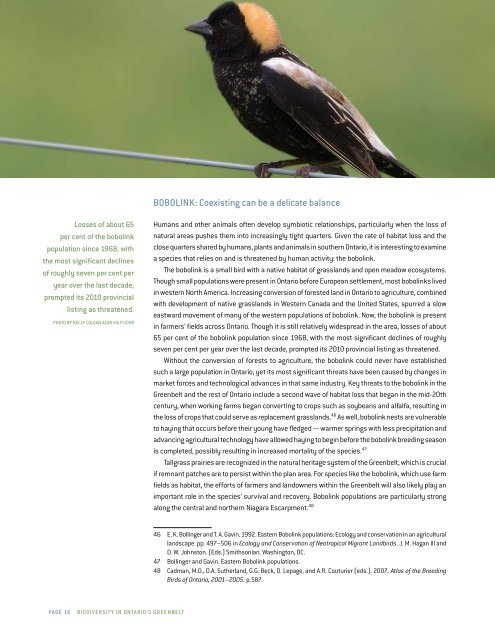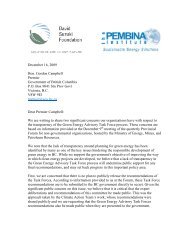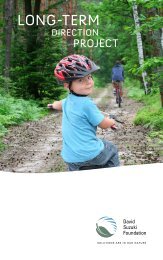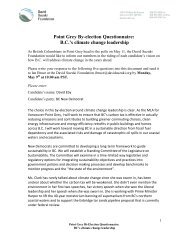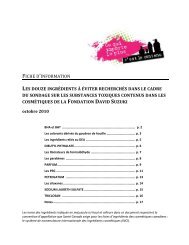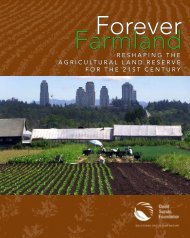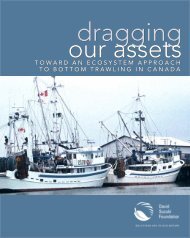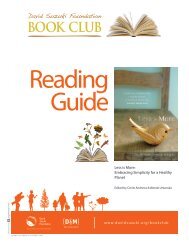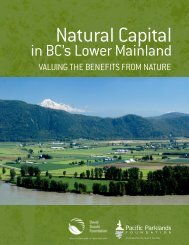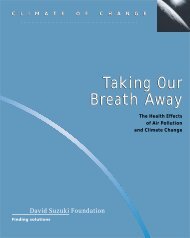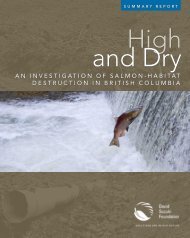Biodiversity in Ontario's Greenbelt (PDF) - David Suzuki Foundation
Biodiversity in Ontario's Greenbelt (PDF) - David Suzuki Foundation
Biodiversity in Ontario's Greenbelt (PDF) - David Suzuki Foundation
You also want an ePaper? Increase the reach of your titles
YUMPU automatically turns print PDFs into web optimized ePapers that Google loves.
Bobol<strong>in</strong>k: Coexist<strong>in</strong>g can be a delicate balance<br />
Losses of about 65<br />
per cent of the bobol<strong>in</strong>k<br />
population s<strong>in</strong>ce 1968, with<br />
the most significant decl<strong>in</strong>es<br />
of roughly seven per cent per<br />
year over the last decade,<br />
prompted its 2010 prov<strong>in</strong>cial<br />
list<strong>in</strong>g as threatened.<br />
photo by Kelly Colgan Azar via flickr<br />
Humans and other animals often develop symbiotic relationships, particularly when the loss of<br />
natural areas pushes them <strong>in</strong>to <strong>in</strong>creas<strong>in</strong>gly tight quarters. Given the rate of habitat loss and the<br />
close quarters shared by humans, plants and animals <strong>in</strong> southern Ontario, it is <strong>in</strong>terest<strong>in</strong>g to exam<strong>in</strong>e<br />
a species that relies on and is threatened by human activity: the bobol<strong>in</strong>k.<br />
The bobol<strong>in</strong>k is a small bird with a native habitat of grasslands and open meadow ecosystems.<br />
Though small populations were present <strong>in</strong> Ontario before European settlement, most bobol<strong>in</strong>ks lived<br />
<strong>in</strong> western North America. Increas<strong>in</strong>g conversion of forested land <strong>in</strong> Ontario to agriculture, comb<strong>in</strong>ed<br />
with development of native grasslands <strong>in</strong> Western Canada and the United States, spurred a slow<br />
eastward movement of many of the western populations of bobol<strong>in</strong>k. Now, the bobol<strong>in</strong>k is present<br />
<strong>in</strong> farmers’ fields across Ontario. Though it is still relatively widespread <strong>in</strong> the area, losses of about<br />
65 per cent of the bobol<strong>in</strong>k population s<strong>in</strong>ce 1968, with the most significant decl<strong>in</strong>es of roughly<br />
seven per cent per year over the last decade, prompted its 2010 prov<strong>in</strong>cial list<strong>in</strong>g as threatened.<br />
Without the conversion of forests to agriculture, the bobol<strong>in</strong>k could never have established<br />
such a large population <strong>in</strong> Ontario, yet its most significant threats have been caused by changes <strong>in</strong><br />
market forces and technological advances <strong>in</strong> that same <strong>in</strong>dustry. Key threats to the bobol<strong>in</strong>k <strong>in</strong> the<br />
<strong>Greenbelt</strong> and the rest of Ontario <strong>in</strong>clude a second wave of habitat loss that began <strong>in</strong> the mid-20th<br />
century, when work<strong>in</strong>g farms began convert<strong>in</strong>g to crops such as soybeans and alfalfa, result<strong>in</strong>g <strong>in</strong><br />
the loss of crops that could serve as replacement grasslands. 46 As well, bobol<strong>in</strong>k nests are vulnerable<br />
to hay<strong>in</strong>g that occurs before their young have fledged — warmer spr<strong>in</strong>gs with less precipitation and<br />
advanc<strong>in</strong>g agricultural technology have allowed hay<strong>in</strong>g to beg<strong>in</strong> before the bobol<strong>in</strong>k breed<strong>in</strong>g season<br />
is completed, possibly result<strong>in</strong>g <strong>in</strong> <strong>in</strong>creased mortality of the species. 47<br />
Tallgrass prairies are recognized <strong>in</strong> the natural heritage system of the <strong>Greenbelt</strong>, which is crucial<br />
if remnant patches are to persist with<strong>in</strong> the plan area. For species like the bobol<strong>in</strong>k, which use farm<br />
fields as habitat, the efforts of farmers and landowners with<strong>in</strong> the <strong>Greenbelt</strong> will also likely play an<br />
important role <strong>in</strong> the species’ survival and recovery. Bobol<strong>in</strong>k populations are particularly strong<br />
along the central and northern Niagara Escarpment. 48<br />
46 E. K. Boll<strong>in</strong>ger and T. A. Gav<strong>in</strong>. 1992. Eastern Bobol<strong>in</strong>k populations: Ecology and conservation <strong>in</strong> an agricultural<br />
landscape. pp. 497–506 <strong>in</strong> Ecology and Conservation of Neotropical Migrant Landbirds. J. M. Hagan III and<br />
D. W. Johnston. (Eds.) Smithsonian. Wash<strong>in</strong>gton, DC.<br />
47 Boll<strong>in</strong>ger and Gav<strong>in</strong>. Eastern Bobol<strong>in</strong>k populations.<br />
48 Cadman, M.D., D.A. Sutherland, G.G. Beck, D. Lepage, and A.R. Couturier (eds.). 2007.. Atlas of the Breed<strong>in</strong>g<br />
Birds of Ontario, 2001–2005. p.587.<br />
Page 16<br />
<strong>Biodiversity</strong> <strong>in</strong> Ontario’s greenbelt


